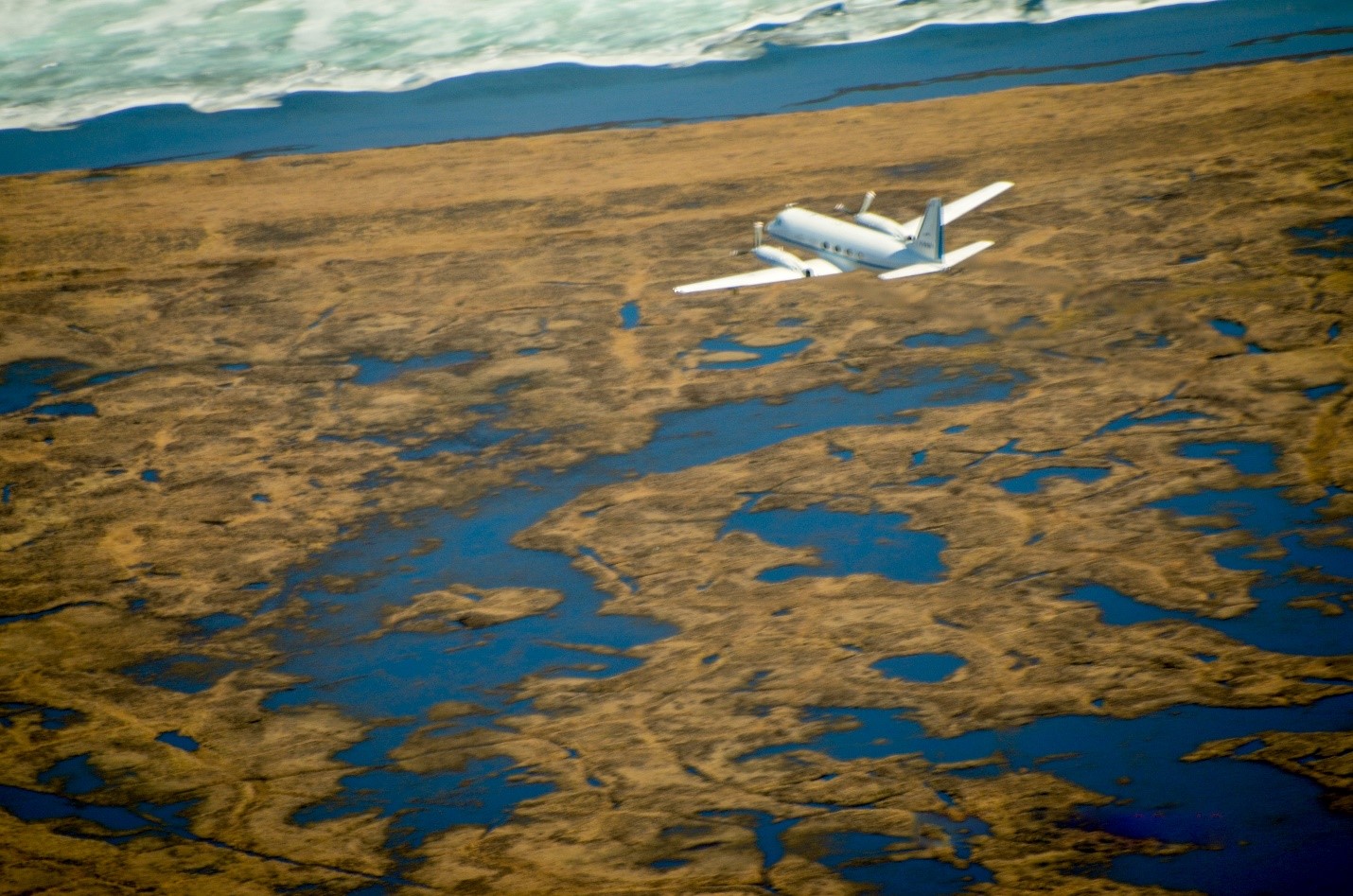ARM’s G-1 Research Aircraft Completes Final Science Mission
Published: 19 February 2019
A new jet will propel the ARM Aerial Facility into the future
On a chilly December afternoon in a quiet corner of the Tri-Cities Airport in Pasco, Washington, coffee and hot cocoa warmed the hands of about 60 people as each scanned the horizon. Idle conversation gave way to cheers as an airplane flew overhead. Minutes later, a vintage turboprop landed, and as it approached its home hangar, it was met with more applause and a water salute by the airport’s firefighting vehicles.
This arrival marked the historic final flight of the Atmospheric Radiation Measurement (ARM) Aerial Facility’s (AAF) Grumman Gulfstream-159 (G-1) aircraft, an airborne scientific platform that—for three decades—helped advance atmospheric research in field campaigns from the Arctic to the tropics, from California to Kuwait.
Once the twin Rolls-Royce turboprop engines thundered to a stop, brief speeches were made on the steps of the plane, and AAF pilots, instrument scientists/engineers, maintenance technicians and support staff received thanks and recognition from ARM Technical Director Jim Mather.
“The people who keep the G-1 flying and keep its scientific instruments operating—up to 50 instruments at a time—deserve our heartfelt thanks,” says Mather. “We have been fortunate to make this research capability available to the scientific community for many years. In fact, several principal investigators from past field campaigns are with us here today. Thank you!”
Many in attendance took Mather up on his invitation to tour the aircraft, and what they saw was much different than the G-1 that first took to the skies in 1961 as an executive, corporate transport with luxury accommodations for 14 passengers. Long gone were the leather recliners, wide aisles, wet bar, and hot towel service.
Today, the G-1’s spartan quarters are filled with racks of scientific instruments and cramped accommodations for researchers.
That conversion happened in 1987, when Battelle, the operator of Pacific Northwest National Laboratory for the U.S. Department of Energy (DOE), purchased the aircraft for atmospheric research. Initially, it was used for DOE’s Atmospheric Chemistry Program and later, the Aerosol Science Program.
Since 2010, says AAF Manager Beat Schmid, the G-1 served as the core of ARM’s aerial research. However, that final arrival on December 17, 2018, marked the end of an era.
“After many years of service, it is time to retire the G-1,” says Schmid. “Gulfstream and Rolls-Royce have stopped supporting the airframe and engines, and it has been increasingly difficult to get parts or have repair work completed. So, with the increasing costs to operate, rising downtime and difficulty certifying new pilots, it’s no longer feasible to use the G-1 going forward.”
During the last two ARM field campaigns, “it was getting harder and harder to maintain the airplane and find parts,” says Schmid. “It was simply no longer economical.”
Memories From the Passenger Seat

From measuring the atmospheric effects of forest fires to flying toward the North Pole just a few hundred feet above sea ice, the G-1 has hosted many memories for the AAF team.
Stories inevitably gravitate to tales of flying toward weather—not around it like most small aircraft. Icing, smoke, turbulence, and operating near severe weather left more than a few principal investigators a bit green and weak-kneed when the G-1 mercifully landed.
The stories are fun, but it’s the resourcefulness and resilience of the AAF team that Schmid likes to discuss. For example, parts availability and maintenance for a 57-year-old airplane were challenges during the recent Aerosol and Cloud Experiments in the Eastern North Atlantic (ACE-ENA) field campaign in the Azores and the G-1’s final field campaign—Cloud, Aerosol, and Complex Terrain Interactions (CACTI) in Argentina—yet the mission goals were met.
“Given the short timeline for CACTI, in particular, I was not convinced we could get it done, but our team did. I am very proud of their accomplishment,” he says.
“On the other end of the spectrum was Brazil, where we worked for four years to get the G-1 into that country for the Green Ocean Amazon (GoAmazon2014/15) field campaign,” adds Schmid. “There were a lot of agencies that told me, ‘It’s never going to happen,’ but we persisted and eventually succeeded. In the end, it was a very successful campaign with many high-level research papers that were published in journals like Science and Nature.”
The Two-Column Aerosol Project (TCAP), a field campaign at Cape Cod, Massachusetts, is also memorable for Schmid.
“The team was hit by a nor’easter, and was snowed under,” he recalls. “The hotel had no power, and the only thing working was a gas fireplace in the lobby. Everybody was huddled there, and some were trying to do their science on the back of napkins.
“I got there a day or two later when they started to dig out,” he adds with a smile.
A Laboratory in the Sky

Over the years, the G-1 was upgraded to enable research missions with a great variety of instrumentation and measurement capabilities, including external probes to measure properties of clouds and aerosols (tiny particles in the air), zenith- and nadir-pointing radiometers, and internal sampling devices. The G-1 offered sufficient cabin volume, electrical power, and payload capacities. It possessed flight characteristics to accommodate a large variety of systems and equipment configurations.
For both the G-1 and future ARM aircraft, a short list of instrumentation and measurement capabilities includes the:
- ultra-high-sensitivity aerosol spectrometer (UHSAS)
- scanning mobility particle sizer (SMPS)
- single-particle soot photometer (SP2)
- dual-column cloud condensation nuclei counter (Dual-CCNC)
- condensation particle counter (CPC)
- ultrafine CPC (UCPC)
- trace gas system (measuring concentrations of sulfur dioxide, carbon monoxide, ozone, nitrogen monoxide, nitrogen dioxide, and nitrogen oxide)
- cavity ring down extinction spectrometer (measuring concentrations of carbon dioxide, methane, and water)
- cloud droplet probe (CDP)
- 2-dimensional stereo probe (2D-S)
- high-volume precipitation spectrometer version 3 (HVPS-3)
- cloud particle imager (CPI).
The ARM Aerial Facility Approach
“Our job is to translate the airborne measurements into accurate data that the ARM user can use in his or her research. It’s quite a challenge, but our team is tremendous.” — Beat Schmid, AAF manager
While ARM is known for its ground-based measurements, many measurements, such as complex chemical composition, cannot be made using remote sensing techniques from the ground. Aerial measurements also provide context for data—a perspective not possible from a fixed location on the ground. “In a nutshell, this is why we have an ARM Aerial Facility,” says Schmid.
As important as the scientific capabilities, it’s the people who bring it together for the ARM users.
“I’m extremely proud to have helped build the ARM Aerial Facility team,” says Schmid. “Their dedication and flexibility are remarkable. For example, a tremendous amount of engineering takes place from one field campaign to the next—and no two campaigns are ever the same. Each has different payloads and instrumentation that must be calculated and balanced.”
Schmid emphasizes that collecting airborne data and atmospheric measurements are not just a matter of technical expertise, but “it’s really an art,” he says. “State-of-the-art measurements in the lab are already very difficult, and now you’re introducing multiple environmental factors to overcome—vibrations, speed and movement, air pressure differentials and more. Our job is to translate the airborne measurements into accurate data that the ARM user can use in his or her research. It’s quite a challenge, but our team is tremendous.”
The AAF team works with each principal investigator to develop the flight plans that best meet the scientific requirements and then obtain approvals from civilian and military aviation authorities and other stakeholders. This includes required safety reviews and interagency coordination for joint campaigns and coordinated flights. After a campaign, AAF scientists assure data quality and document and archive data sets (freely available to anyone) that include:
- in situ measurements of aerosols, clouds, and trace gases
- sampling not possible using surface- or satellite-based techniques
- measurements for validating surface- or satellite-based techniques
- context for and extension of surface-based measurements
- measurements for testing and evaluating models.
The AAF’s focus on serving the broader science community and its operational approach are documented in “The DOE ARM Aerial Facility,” an overview article published in 2014 in the Bulletin of the American Meteorological Society.
Flying Into the Future

The aging of and eventual need to replace the much-loved G-1 was no surprise to program managers or DOE. With an appreciation for the importance of the AAF’s mission, Congress allocated fiscal year 2019 funding of $17.5 million to purchase and retrofit a new research aircraft.
To offer the science community more physical space in the aircraft, additional types of aerial sampling, and the ability to fly longer and higher than the G-1, ARM recently issued a Request for Proposal and plans to have the new jet take on its first ARM science mission in late 2022 or early 2023. The new airplane will be a Bombardier CRJ 200 or Challenger 850 regional jet.
Produced from 1991 to 2006, the airline version of the Bombardier CRJ 200 typically has 40 to 50 seats and is highly regarded for fuel efficiency. Based on the CRJ 200, the Challenger 850 (built until 2012) is the largest business aircraft offered by Bombardier.
In anticipation of the new jet, the Port of Pasco recently partnered with Pacific Northwest National Laboratory, DOE, the Washington State Community Economic Revitalization Board, and the Franklin County Economic Development Fund to break ground on a larger hangar. Construction of the $3.4 million, 18,240-square-foot facility is expected to take about eight months.
Keep up with the Atmospheric Observer
Updates on ARM news, events, and opportunities delivered to your inbox
ARM User Profile
ARM welcomes users from all institutions and nations. A free ARM user account is needed to access ARM data.


















